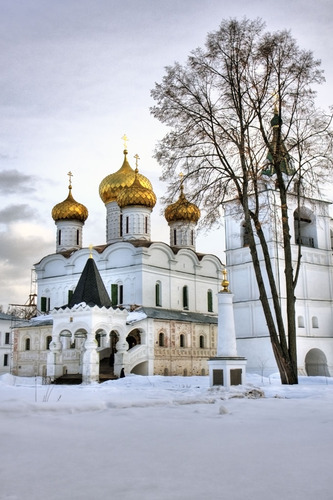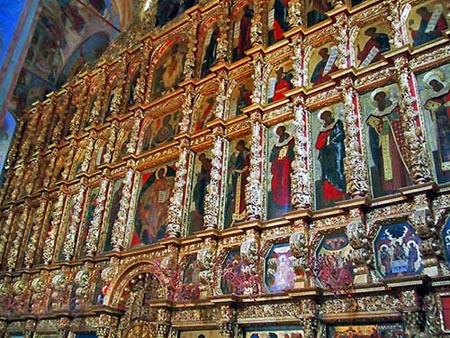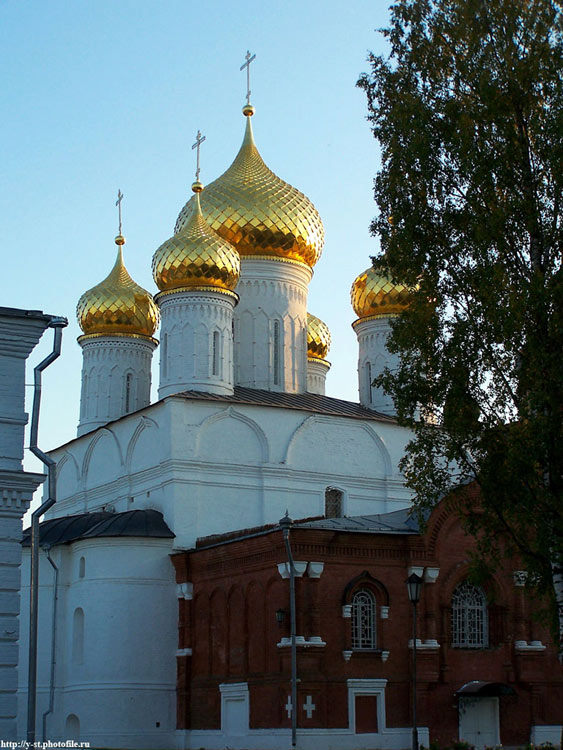1330, Troitsky Cathedral 1652

Photo Panoramio
Troitsky Cathedral 1652
Kostroma
Link to Google-Earth file Kostroma.kmz
This requires that you have GE on your hard disc.
History of Kostroma
Some
historians believe the town could have been founded by Yury Dolgoruky
more than half a century earlier. Like other towns of the Eastern
Rus, Kostroma was sacked by the Mongols in 1238. It then constituted
a small principality, under leadership of Prince Vasily the Drunkard,
a younger brother of the famous Alexander Nevsky. Upon inheriting the
grand ducal title in 1271, Vasily didn't leave the town for Vladimir,
and his descendants ruled Kostroma for another half a century, until
the town was bought by Ivan I of Moscow.
As one of the
northernmost towns of Muscovy, Kostroma served as a place of retreat
for the grand dukes when enemies besieged Moscow in 1382, 1408, and
1433. The spectacular growth of the city in the 16th century may be
attributed to the establishment of trade connections with English and
Dutch merchants (Muscovy Company).
Boris Godunov had the
Ipatievsky and the Epiphany monasteries rebuilt in stone. The
construction works were finished just in time for the city to witness
some of the most dramatic events of the “Time of Troubles”.
Kostroma was twice ravaged by the Poles; it took a 6-month
siege to expel them from the Ipatievsky monastery. The heroic peasant
Ivan Susanin became a symbol of the city's resistance to the Polish
invaders; several monuments to him may be seen in Kostroma. The
future tsar, Michael Romanov, had also found asylum at the monastery.
It was here that an embassy from Moscow offered him the Russian crown
in 1612.
The Romanovs regarded Kostroma as their personal
protectorate especially the Ipatievsky monastery. They had the
Trinity Cathedral rebuilt in 1652; its frescoes and iconostasis are a
thing of beauty.
Text from Wikipedia
Kostroma
Ipatievsky Monastery
1330,
Troitsky Cathedral 1652 
Photo Panoramio
Troitsky Cathedral 1652
The Ipatiev Monastery was founded 1330 by the Tartar prince Zakharias Tchet, the founder of the Godunov family, who had fled from the Golden Horde to Moscow and had been baptized there. It stands on the spot where the Virgin appeared to him together with St Ipatiev. By 1590 the monastery had evolved into a small fortress, so that Mikhail Feoderovich Romanov could find shelter there from the invading Poles. Here he was persuaded by the Russian boyars and clergy in 1613 to accept the crown. Thus was founded the Romanov dynasty.

Photo
John Glines. pbase.com
Doorway in the cathedral of the Ipatievsky Monastery after a
recent restoration.

Photo
John
Glines. travel.webshots.com
The massive iconostasis in
the Trotsky Cathedral, 1652 and later.
Kostroma
Bogoyavlensko-Anastasy (Epiphany) Monastery
1559

Photo sobory.ru
The Anastasy Cathedral
The
Bogoyavlensky Monastery was founded in the 1559 by Nikita who was a
disciple and a relative by Sergy of Radonezh. At present it is
inhabited by nuns. In the 70s
the church was
off limits to visitors. 
Photo
Wikipedia
The
miraculous icon of Our Lady of St Theodore is now housed here.
Orthodox Christians believe her to be the protectress of Kostroma.